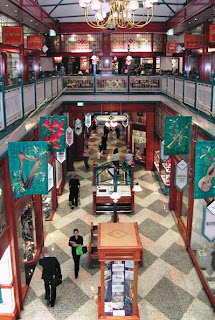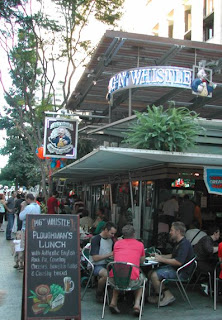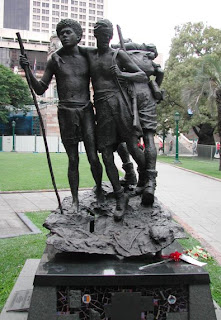
South Bank Parklands are on the southern bank of the Brisbane River, at South Bank, directly opposite the CBD. The parklands are connected to the central business district by the Victoria Bridge at the northern end and the Goodwill Bridge at the southern end. It features 17 hectares of lush gardens and lawns. There are markets, shopping, restaurants, cafes, accommodation, swimming on a man made beach, and numerous other activities to partake there. I believe it is one of the best parkland areas in the world.
 The obvious feature, given that they are parklands, is the lush nature of the greenery. Nowhere is this more apparent than in the Rainforest Walk area, which is in the northern section of the parklands. There are a number of raised wooden walkways, which meander through, around and over water features, thick ground cover, and are shaded by the overhead canopy of a replicated rainforest. There are stairs in certain areas, although if you are wheelchair bound there are multiple access points so you can enjoy it regardless of these types of obstacles.
The obvious feature, given that they are parklands, is the lush nature of the greenery. Nowhere is this more apparent than in the Rainforest Walk area, which is in the northern section of the parklands. There are a number of raised wooden walkways, which meander through, around and over water features, thick ground cover, and are shaded by the overhead canopy of a replicated rainforest. There are stairs in certain areas, although if you are wheelchair bound there are multiple access points so you can enjoy it regardless of these types of obstacles.  My kids love South Bank, not only because it means they're going to get Ice Cream, but because of the vast array of activities there. Whenever we walk through the Rainforest Walk, we always discover lizards or wee beasties which my middle son delights in discovering and pointing out. My eldest loves that there are so many people around that he can annoy, and the toddler spends most of the time pointing at things saying "What's that?" What more can you ask for of an area which excites and engages their senses. Oh, and gets me Ice Cream as well!
My kids love South Bank, not only because it means they're going to get Ice Cream, but because of the vast array of activities there. Whenever we walk through the Rainforest Walk, we always discover lizards or wee beasties which my middle son delights in discovering and pointing out. My eldest loves that there are so many people around that he can annoy, and the toddler spends most of the time pointing at things saying "What's that?" What more can you ask for of an area which excites and engages their senses. Oh, and gets me Ice Cream as well!Cheers, I Love Brisbane, Wes.
Click Here for the Google Map Reference for this post.
















































